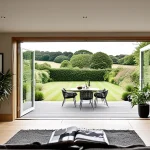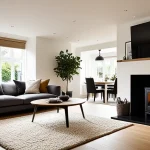Transform Your UK Home into a Tranquil Oasis: A Comprehensive Guide
In the hustle and bustle of modern life, creating a tranquil oasis in your home can be a game-changer for your mental and physical well-being. Whether you live in a bustling city or a quieter suburb, transforming your space into a serene retreat is achievable with the right design elements and a bit of creativity. Here’s how you can turn your UK home into a peaceful haven.
Understanding the Concept of a Tranquil Oasis
Before diving into the specifics, it’s essential to understand what a tranquil oasis is. A tranquil oasis is a space that provides a sense of calm and serenity, often by incorporating elements of nature and thoughtful design. It’s a place where you can escape the stresses of daily life and recharge.
Topic to read : What Are the Best Tips for Creating a Cozy Living Space in the UK?
The Importance of Nature
Nature plays a crucial role in creating a tranquil atmosphere. Studies have shown that being around plants and natural elements can reduce stress levels, improve mood, and even lower blood pressure. Here’s how you can bring nature into your home:
- Indoor Plants: Adding indoor plants like peace lilies, snake plants, or lavender can not only purify the air but also create a calming ambiance. Choose low-maintenance plants if you don’t have a green thumb.
- Outdoor Garden: If you have the space, creating a garden in your backyard can be incredibly rewarding. Plant a variety of flowers, shrubs, and trees that are native to the UK to attract local wildlife and enhance the natural beauty of your space.
Designing Your Garden
Your garden is a critical component of your outdoor space and can significantly contribute to the tranquility of your home. Here are some tips for designing a serene garden:
In parallel : What are the top DIY projects to enhance your UK home’s value?
Garden Design Elements
- Water Features: Incorporating a water feature, such as a small pond or a fountain, can add a soothing sound to your garden. Water features are known to create a calming effect and can attract birds and other wildlife.
- Example: A small solar-powered fountain can be an easy and eco-friendly way to add the sound of water to your garden.
- Seating Areas: Create inviting seating areas where you can relax and enjoy your garden. Choose comfortable outdoor furniture that complements the natural surroundings.
- Example: A wooden bench under a shaded area or a hammock between two trees can be perfect spots to unwind.
- Lighting: Proper lighting can make your garden accessible and enjoyable even in the evening. Use solar-powered lights or string lights to create a warm and inviting ambiance.
- Example: Fairy lights wrapped around trees or along pathways can add a magical touch to your garden.
Seasonal Considerations
Your garden design should also consider the changing seasons in the UK. Here’s a seasonal breakdown to help you plan:
| Month | Seasonal Tips |
|---|---|
| January-February | Plant winter flowers like snowdrops and hellebores. Ensure your garden is well-drained to prevent waterlogging. |
| March-April | Start planting spring bulbs and vegetables. Prune trees and shrubs to maintain shape. |
| May-June | Plant summer flowers and vegetables. Add mulch to retain moisture and suppress weeds. |
| July-August | Keep your garden well-watered, especially during hot spells. Deadhead flowers to encourage more blooms. |
| September-October | Plant autumn flowers and vegetables. Start preparing your garden for winter by clearing debris. |
| November-December | Plant winter flowers and bulbs. Protect sensitive plants from frost using covers or bringing them indoors. |
Creating a Peaceful Outdoor Space
Your outdoor space is an extension of your home and can be transformed into a tranquil oasis with careful planning.
Furniture and Layout
- Choose Comfortable Furniture: Select outdoor furniture that is both comfortable and durable. Consider weather-resistant materials like wicker, rattan, or recycled plastic.
- Example: A plush outdoor sofa set with a coffee table can create a cozy seating area.
- Optimize Layout: Arrange your furniture to create different zones within your outdoor space. This could include a dining area, a reading nook, or a relaxation zone.
- Example: Use a pergola or a gazebo to define different areas and add shade.
Adding Elements of Nature
Incorporating natural elements into your outdoor space can enhance its tranquility.
- Plants and Greenery: Besides a garden, you can add plants and greenery to your outdoor space through hanging baskets, planters, or a vertical garden.
- Example: Hang ferns or ivy from a pergola to create a lush canopy.
- Water Features: As mentioned earlier, water features can be incredibly calming. Even a small birdbath or a self-contained fountain can make a difference.
- Example: A solar-powered birdbath can attract birds and add the soothing sound of water to your outdoor space.
Transforming Your Home into a Tranquil Oasis
While the outdoor space is crucial, transforming your home itself into a tranquil oasis is equally important.
Interior Design Tips
- Color Scheme: Choose a calming color scheme for your interior. Shades of blue, green, and neutral tones like beige and gray can create a serene atmosphere.
- Example: Paint your living room a soft blue to evoke feelings of calmness.
- Lighting: Lighting can significantly impact the ambiance of your home. Use soft lighting options like table lamps or floor lamps to create a warm and inviting atmosphere.
- Example: Use string lights or fairy lights in your living room to add a cozy touch.
- Furniture and Layout: Ensure your furniture is comfortable and arranged in a way that promotes relaxation. Avoid clutter and keep your space organized.
- Example: Use a plush area rug and comfortable seating to create a cozy reading nook.
Incorporating Natural Elements Indoors
Bringing natural elements indoors can enhance the tranquility of your home.
- Indoor Plants: As mentioned earlier, indoor plants are not only good for air quality but also for mental health.
- Example: Place a peace lily in your bedroom to promote better sleep.
- Natural Materials: Use natural materials for your furniture and decor, such as wood, stone, or bamboo.
- Example: Use a wooden coffee table or a stone vase to add natural elements to your living room.
Practical Insights and Actionable Advice
Here are some practical tips and actionable advice to help you transform your home into a tranquil oasis:
Create a Morning Routine
Starting your day in a peaceful environment can set the tone for the rest of the day.
- Wake Up to Nature: Open your curtains to let natural light in, and take a few minutes to enjoy the view of your garden or outdoor space.
- Meditate or Practice Yoga: Begin your day with a short meditation or yoga session in a quiet corner of your home.
Use Technology Wisely
Technology can both enhance and disrupt your peaceful environment. Here’s how to use it wisely:
- Smart Lighting: Use smart lighting systems to adjust the lighting in your home according to the time of day or your mood.
- Noise Cancellation: Invest in noise cancellation headphones or use white noise apps to block out external noise.
Maintain Your Space
Regular maintenance is key to keeping your tranquil oasis intact.
- Weekly Cleaning: Set aside time each week to clean and maintain your indoor and outdoor spaces.
- Seasonal Updates: Update your garden and outdoor space seasonally to ensure they remain vibrant and inviting.
Transforming your UK home into a tranquil oasis is a journey that requires careful planning, creativity, and a bit of effort. By incorporating elements of nature, designing your garden and outdoor space thoughtfully, and using interior design tips, you can create a peaceful retreat that enhances your well-being.
Final Tips
- Be Patient: Creating a tranquil oasis takes time. Be patient and enjoy the process.
- Make It Personal: Tailor your space to your personal preferences and needs.
- Seek Inspiration: Look for inspiration from various sources, including nature, travel, and design magazines.
By following these tips and advice, you can turn your home into a serene haven that provides you with the peace and tranquility you deserve.
Detailed Bullet Point List: Elements to Create a Tranquil Oasis
- Indoor Plants:
- Peace lilies
- Snake plants
- Lavender
- Ferns
- Ivy
- Outdoor Garden Elements:
- Water features (ponds, fountains)
- Seating areas (benches, hammocks)
- Lighting (solar-powered lights, string lights)
- Seasonal flowers and vegetables
- Furniture and Layout:
- Comfortable outdoor furniture (wicker, rattan)
- Optimized layout (different zones for dining, reading, relaxation)
- Natural materials (wood, stone, bamboo)
- Lighting:
- Soft lighting options (table lamps, floor lamps)
- Smart lighting systems
- Natural Elements Indoors:
- Indoor plants
- Natural materials for furniture and decor
- Technology:
- Smart lighting systems
- Noise cancellation headphones or white noise apps
- Maintenance:
- Weekly cleaning
- Seasonal updates for garden and outdoor space
Comprehensive Table: Seasonal Garden Tips
| Month | Seasonal Tips |
|---|---|
| January-February | Plant winter flowers like snowdrops and hellebores. Ensure your garden is well-drained to prevent waterlogging. |
| March-April | Start planting spring bulbs and vegetables. Prune trees and shrubs to maintain shape. |
| May-June | Plant summer flowers and vegetables. Add mulch to retain moisture and suppress weeds. |
| July-August | Keep your garden well-watered, especially during hot spells. Deadhead flowers to encourage more blooms. |
| September-October | Plant autumn flowers and vegetables. Start preparing your garden for winter by clearing debris. |
| November-December | Plant winter flowers and bulbs. Protect sensitive plants from frost using covers or bringing them indoors. |
Relevant Quotes
- “Nature is not a place to visit. It is home.” – Gary Snyder
- This quote emphasizes the importance of integrating nature into our daily lives, which is a core principle of creating a tranquil oasis.
- “The clearest way into the Universe is through a forest wilderness.” – John Muir
- This quote highlights the therapeutic benefits of being in nature, which can be replicated in your own home by creating a peaceful and natural environment.







